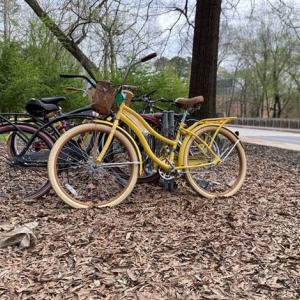
We Are All Earthlings
Posted
Throughout recent years, discussion of sustainability, environmental justice, and generally being kinder to Mother Earth have become mainstream topics. While being mindful of our consumption habits has been a big discussion point, many still feel lost when it comes to everyday environmentally positive swaps.

Work in the Time of Corona: Amber Blanton, Makerspace Student Assistant
Posted
A new W&M blog series. In this post, Amber Blanton chronicles what it's like to work in the time of Corona.

Work in the Time of Corona: Sara Belmont, Web Developer
Posted
A new W&M blog series. In this post, Sara Belmont chronicles what it's like to work in the time of Corona.

Documenting Life During Pandemic
Posted
Share your own personal stories of life during COVID-19 with W&M Libraries!

Work in the Time of Corona: Kate McCallister, Catalog and Metadata Librarian
Posted
A new W&M blog series. In this post, Kate McCallister chronicles what it's like to work in the time of Corona.

Our Town
Posted
The COVID-19 coronavirus pandemic stormed into Williamsburg the middle weeks of March. When W&M students left campus for spring break on Friday, March 6, normal prevailed. A week later, profound changes were underway.

"Simba Answers Call of the Wild"
Posted
A recent addition to the Thomas L. Williams Collection reveals one cautionary tale about exotic pet ownership here in Williamsburg, Virginia.

Work in the Time of Corona: Shayna Gutcho, Mosaic Fellow
Posted
A new W&M blog series. In this post, Shayna Gutcho chronicles what it's like to work in the time of Corona.

Working Alone, Together
Posted
Our library staff members are chronicling their experiences living through a pandemic. In this post Research Librarian, Liz Bellamy, writes about how the Research and Instruction team is working alone, together.

Work in the Time of Corona: Gina Woodward, Delivery Service Coordinator
Posted
A new W&M blog series. In this post, Gina Woodward chronicles what it's like to work in the time of Corona.

COVID-19, Library Instruction, and Me
Posted
One of the experiences Mosaic Fellows acquire during their studies is teaching and library instruction. However, the COVID-19 pandemic has altered the way teaching and instruction is now being taught to students at William & Mary. Yitazba chronicles her journey leading her first online library instruction session.

Work in the Time of Corona: Libby McDaniel, Head of Cataloging & Metadata
Posted
A new W&M blog series. In this post, Libby McDaniel chronicles what it's like to work in the time of Corona.

Seabees at Pearl Harbor: James W. Caywood Scrapbook
Posted
Introducing a recently digitized scrapbook documenting the experiences of an African American sailor during the attack on Pearl Harbor

Librarian Problem Solver: Ebooks to the Rescue
Posted
Getting access to eBooks for courses and student is on all of our minds. Professors need course materials they assigned available in electronic formats and librarians were here to answer the call.

Work in the Time of Corona: Justin Dalton, Applications Administrator
Posted
A new W&M blog series. In this post, Justin Dalton chronicles what it's like to work in the time of Corona.

The Yellow Bicycle
Posted
W&M Libraries board member Tracy Melton '85 tells a touching story of the impact the pandemic has had on the Williamsburg community.

Work in the Time of Corona: Mildred Sink, Swem Circulation
Posted
A new W&M blog series. In this post, Mildred Sink chronicles what it's like to work in the time of Corona.

Librarian Problem Solvers - For the New K-12 Kitchen Table Teachers
Posted
Faculty and staff who are suddenly in charge of homeschooling K-12 students are looking for helpful resources beyond what is supplied by the teacher. Rebecca Beasley, Librarian and Director of the School of Education's Learning Resource Center, shares some tools to help.

Work in the Time of Corona: Carolyn Wilson, SCRC Research Assistant
Posted
A new W&M blog series. In this post, Carolyn Wilson chronicles what it's like to work in the time of Corona.

While You Were Gone : We Were Here
Posted
In this post, the Swem Circulation Department chronicles what it was like to work in that in-between time.

